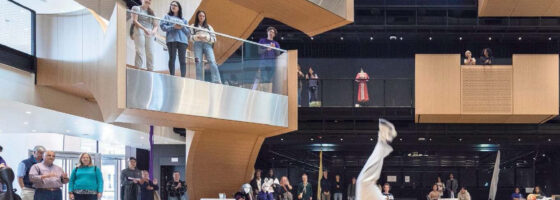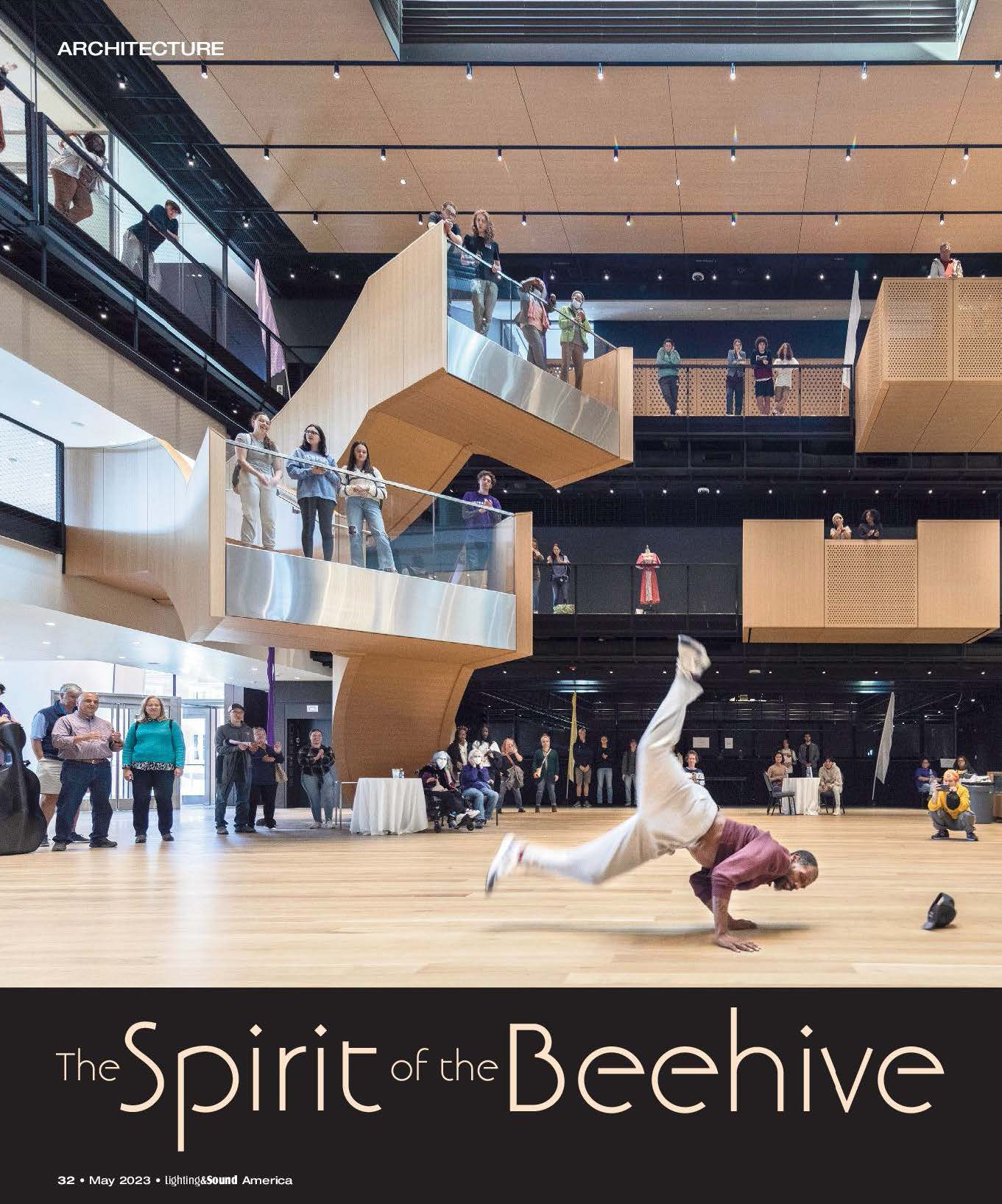Prior PAC Featured in Lighting & Sound America
Catherine Halstead, Marketing Communications Manager | June 21, 2023

The new Prior Performing Arts Center at the College of the Holy Cross has been featured in Lighting & Sound America, with interviews given by Jaffe Holden’s own Matt Nichols, Principal of Acoustics, and Ben Bausher, Associate Principal of Audio/Video. You can read the full article here.
The following is an excerpt from Lighting & Sound America, written by David Barbour:
The oldest Roman Catholic college in New England has gotten an up-to-date new facility. The Prior Performing Arts Center, located at the College of the Holy Cross in Worcester, Massachusetts, is a laboratory of multidisciplinary education incorporating performing and visual arts. Arranged around a central area, known as the Beehive, are four pavilions, containing a 400-seat convertible concert hall and proscenium theatre for opera and music, a 200-seat flexible studio theatre, an art gallery, classrooms, and rehearsal and production spaces.
In a notably intricate arrangement, the four pavilions are placed inside two pairs of walls that, intersecting, form a nine-square grid, the corner of each featuring a courtyard garden, amphitheatre, outdoor teaching area and work shop, and meditative and sculpture gardens. According to the building’s design architect Diller Scofidio + Renfro, “The paired walls twist, rise, and interlock, the wall of one pavilion becoming the roof of its neighbor, forming a chain around the center and creating arched entries directly into the heart of the building. The opposing precast concrete and weathering steel walls reinterpret the brick and lime stone of the historic campus.”
Charles Renfro, partner at DS+R and partner-in-charge for the performing arts center, says. “The new Prior Performing Arts Center is an uncommon commons. The building is uniquely perched on a hill overlooking the campus and Worcester yet straddles the intersection of multiple cross-campus paths. While its world-class facilities provide a singular new home for Holy Cross’ performing arts students, its atrium invites the broader student body to participate in casual and unscripted creative activities. The building’s dual identity is also expressed in its materials, which are tough and industrial without sacrificing warmth and comfort. We’re excited for the performing arts center to welcome students and faculty into a new kind of space for Holy Cross – one that puts intersectionality, inclusion, and interdisciplinarity at its heart.”
Working with the theatre consultancy Fisher Dachs Associates and the acoustic and AV consulting firm Jaffe Holden, the project, which cost $110 million, is notable for its flexibility and transparency, the latter feature realized in the overt use of glass walls that puts most of the activity in the building on display. It’s a kind of factory of the arts, in which the methods of manufacturing are always visible.
Concert hall sound
Matt Nichols, principal at Jaffe Holden, notes that the biggest acoustic challenge has to do with the transparency dictum, which resulted in all those glass walls. “The Beehive opens to practice rooms, galleries, and studios, with glass everywhere. It’s a major acoustical challenge. We used a lot of thick laminated glass and box-in-box construction, along with a curtain wall overlooking over of the studios and practice rooms.”
Turning to the concert hall, he says the client “wanted natural acoustics. We started with the idea of non-amplified orchestral performing, the optimum acoustical environment consisting of a reverb time of two seconds, for a feeling of warm envelopment; we also needed to have an appropriate room height to support this.” The acoustical banner system supplied by Wenger/J.R. Clancy, he says, consists of “thousands of square feet of banners that can drop down to various settings. The banners are stored for acoustical ensembles, such as symphony performances,” and are lowered in for electronic music of various kinds.
Nichols says the walls themselves are constructed of GFRG, glass fiber-reinforced gypsum, a panelized system designed to replicate acoustical diffusion. They are also designed to look like drapes. “The challenge was how to construct wavy, drape-like materials to reflect and diffuse sound for orchestral performances. It’s a panelized system that we designed to replace a natural diffusor; using a mathematical equation, we incorporated a pattern into the design and tested it in the laboratory to make sure that the panels didn’t resonate, which would not be ideal.”
Another major challenge was something you don’t see in a concert hall every day. “There’s glass on the upstage wall,” Nichols says. To create the desired acoustical isolation, Jaffe Holden came up with a triple-layer solution. “It features insulated glass on the exterior side and laminated glass on the interior with a large, heavily vented air space between them.” The team also worked to isolate the concert hall from the parking lot outside. “The hall’s rating is NC-15; when you have a space that quiet, any external noise can be detected. We put heavy Plexiglas on the wall; it allows light to pass through and can be blacked out.”
Ben Bausher, associate principal of audio/video at Jaffe Holden, says the loudspeaker system in the concert hall consists of T-Series, d&b audiotechnik’s smallest line arrays. “The room is about 50′ from the proscenium to the back wall,” he says. “It’s very wide, but you don’t have to put out a great deal of sound to the back of the room.” The system is laid out as left, right, and center proscenium arrays with additional units for the underbalcony and fill for the extreme left and right sides. “There’s also a distributed horizontal sub array on the catwalk,” he says. “I’m a fan of all d&b products; they have a very consistent voicing. Tuning the system is much easier than with others that don’t have that characteristic.”
Interestingly, sound is controlled using an Allen & Heath OLIVE S7000 mixer. “They have one in each space,” Bausher says. “The client wanted a console that supports 96kHZ. With it, the theatres can act as live rooms for the recording studio located on the building’s third floor], being linked to it via Dante. Allen & Heath has been a leader in having 96kHZ on its consoles and the dLive had the right feature set, including lots of matrices, channels, and outputs.” The audio package also includes a full microphone kit drawing on Shure’s ULX-D line. A mixing booth is located at the rear of the room, with space also provided for a house mixing position. “Everything goes into Dante to move the audio around, with portable stage box interfaces for extra inputs,” says Rich Gold of Metinteractive, the building’s AV gear supplier. “The theatre is wired with panels to patch in audio inputs as needed, and there are patch bays in the equipment racks for maximum flexibility.” Because the school already owned a Panasonic projector, a full Crestron control system was also installed, along with infrastructure for a surround sound system.


Comments